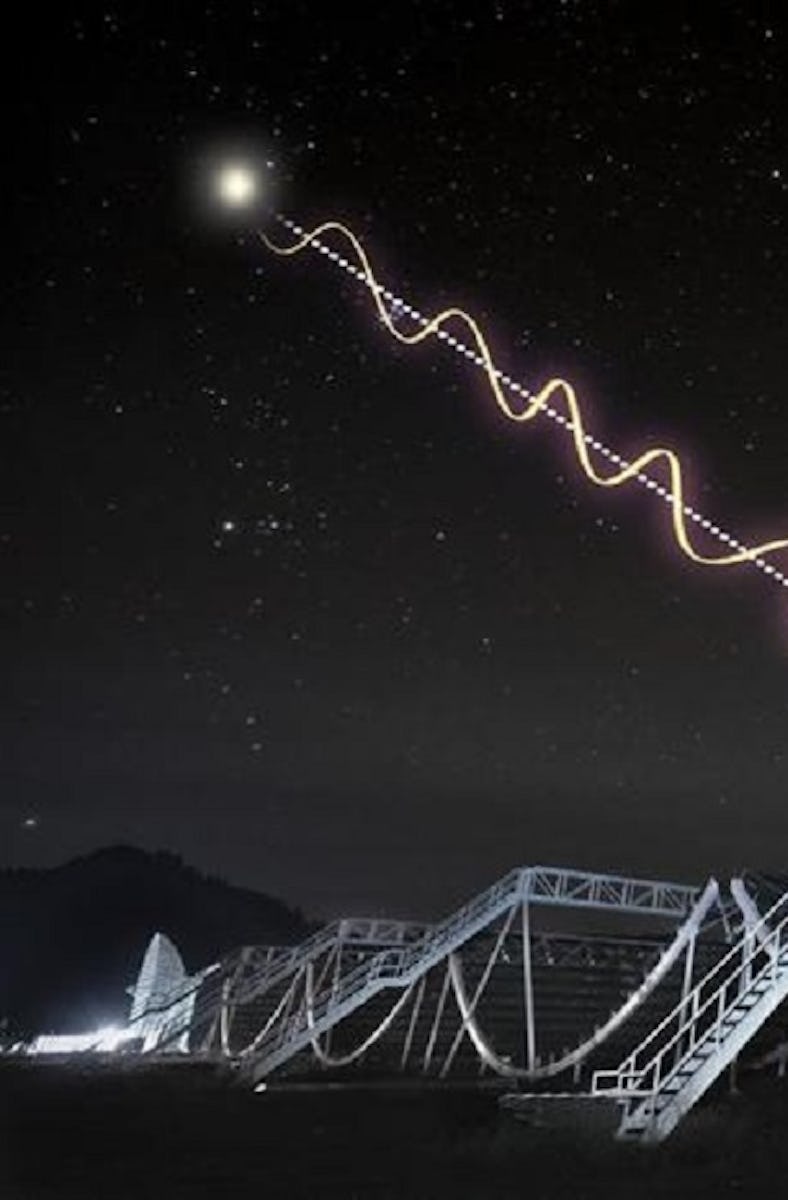Elusive Fast Radio Bursts In Space Probably Come From the Most Ordinary Galaxies
A recent study traced 28 fast radio bursts to very average galaxies, with unremarkable magnetic fields and very little drama.

Most fast radio bursts come from quiet galaxies like ours, suggests a recent study which traced 28 of them to their sources.
Fast radio bursts are exactly what they claim to be: short, intense bursts of radio waves, usually from stars in other galaxies. About 3 percent of the 1,000 astronomers have caught in the act so far repeat themselves, while the vast majority seem to scream into the void once and then fall silent. That 3 percent, because they’re so much easier to study, have received most of the attention. But a recent study suggests that the non-repeaters come from very different places than their more reliable cousins. University of Toronto astrophysicist Ayush Pandhi and his colleagues published their work in The Astrophysical Journal.
This artist’s rendition illustrates how the angle of polarized light from an FRB changes as it journeys through space.
A Polarizing Issue in Physics
Pandhi and his colleagues recently spotted 28 fast radio bursts — all one-offs, not repeaters — in data from the Canadian Hydrogen Intensity Mapping Experiment, or CHIME, a radio telescope in British Columbia, Canada. CHIME surveys a wider swath of sky than most radio telescopes, so it has a better chance of catching the non-repeating fast radio bursts in action. And in each fast radio burst CHIME recorded, the radio waves carried a record of where they had come from, hidden in the polarization of the waves.
Polarization means that all the waves in a beam of light (or radio signal, which is just very, very long wavelengths of the same sort of energy as light) are oriented in the same direction. Picture a flashlight beam; its light waves are all moving in the same general direction, but some of them might be vibrating up and down, while others might be oscillating left to right, or on a diagonal. That beam of light isn’t polarized. Now picture a computer screen that polarizes that light so that all the waves are oscillating in the same left-to-right direction. That’s why you sometimes can’t read that type of computer screen unless you’re right in front of it.
By studying how polarized the radio waves from the distant fast radio bursts appeared, Pandhi and his colleagues could glean some information about how dense the space around the burst had been, and how strong its host galaxies magnetic field was.
“The angle of polarization of the light rotates as it encounters electrons and/or magnetic fields,” Pandhi tells Inverse. “The higher the density of electrons (and/or the stronger the magnetic fields) that it encounters are, the more that angle rotates.”
Each fast radio burst contained several wavelengths of radio waves, and Pandhi and his colleagues studied those wavelengths individually. When radio waves encounter a dense cloud of electrons or a strong magnetic field, longer wavelengths rotate faster than slower ones. So by comparing how much each wavelength of the signal had rotated, Pandhi and his colleagues could glean more detailed information about the density of charged gas, and the strength of the magnetic field, they had passed through on their way to Earth.
It turns out that the 28 fast radio bursts CHIME observed had some from galaxies like ours, with middle-of-the road gas density and fairly modest magnetic fields.
Source of Fast Radio Bursts Still A Mystery
That makes Pandhi and his colleagues’ 28 one-off fast radio bursts look very different from the repeating bursts that other studies have focused on. Repeating fast radio bursts seem to come from young galaxies very densely packed with electrons and equipped with extreme magnetic fields. And it may lend some credence to the idea that the repeaters and the one-offs are the result of two completely different cosmic events — even if we still don’t know what either event actually is.
“Whether repeating and non-repeating FRBs are two distinct populations remains one of the biggest questions in the field,” says Pandhi. “After completing this project, I definitely believe that there are physical differences between repeating and non-repeating FRBs, but I'm not yet convinced that they're two entirely separate populations. I think that, likely, they are on two ends of a continuous population spectrum but that there might be some room for overlap.”
Some astrophysicists have suggested that repeating fast radio bursts may be caused by a younger, more active version of whatever phenomenon causes them, while the one-offs are occasional outbursts from older, more settled versions of the mysterious source.
What’s Next?
To answer that question — and the basic question of what causes fast radio bursts in the first place — astrophysicists will need more data, which means observing more fast radio bursts.
“Of course, we will continue to monitor and study more FRBs with CHIME,” says Pandhi. “But I am currently focused on using data from another radio telescope, the Karl G. Jansky Very Large Array, to more closely study the environments of a few FRBs and better disentangle the effect that our own Milky Way has on the FRBs' polarization properties from that of their host galaxies.”